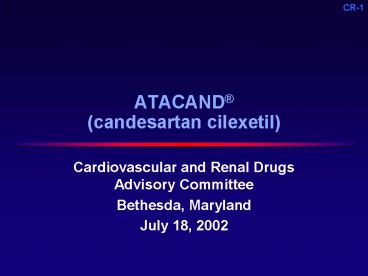ATACAND PowerPoint PPT Presentation
1 / 13
Title: ATACAND
1
ATACAND(candesartan cilexetil)
C
- Cardiovascular and Renal DrugsAdvisory Committee
- Bethesda, Maryland
- July 18, 2002
2
ATACAND Introduction and Regulatory Overview
C
- Cindy Lancaster, MS, MBA, JD
- Director, Regulatory Affairs
- AstraZeneca
3
Agenda for Presentation
- Regulatory Overview Cindy Lancaster, MS, MBA,
JD Director, Regulatory Affairs AstraZeneca - Comparison of Vasilios Papademetriou, MD,
Antihypertensive Efficacy DSc, FACCof
Candesartan Cilexetil Professor of Medicineand
Losartan Georgetown University - Epidemiologic and Clinical William B. Kannel,
MD, FACCSignificance of Incremental Professor
of Medicine andChanges in Blood Public
HealthPressure Boston University School of
Medicine - Summary Cindy Lancaster, MS, MBA, JD Director,
Regulatory Affairs AstraZeneca
4
Consultant and Sponsor Representatives
- Consultant
- Donald Vidt, MD, FACC
- Principal Investigator for Study 230
- Consultant, Department of Hypertension and
Nephrology, The Cleveland Clinic Foundation - Professor of Medicine, Ohio State University
- AstraZeneca
- Eric Michelson, MD, FACC
- Senior Director, Clinical Research
- Conrad Tou, PhD
- Associate Director, Biostatistics
- Jennifer Sugg, MS
- Senior Statistical Scientist
- Glenn Carlson, MD
- Senior Director, Medical
5
Introduction
- ATACAND (candesartan cilexetil)
- Selective AT1 subtype angiotensin II receptor
antagonist (ARB) - June 1998Approved for the treatment of
hypertension - Can be used alone or in combination with other
antihypertensive agents - Usual recommended starting dose 16 mg QD
6
Regulatory HistoryAgency Interactions (1)
- Original NDA
- Included 1 positive comparative study versus
losartan, SH-AHM-0001 - Randomized, double-blind, multicenter,
placebo-controlled, parallel-group, 8-wk duration - Patients (N 337) with a mean diastolic blood
pressure of 95 to 114 mm Hg - Compared candesartan cilexetil 8 and 16 mg
QD,losartan 50 mg QD, and placebo - The proposed labeling did not include comparator
text versus losartan
7
Regulatory HistoryAgency Interactions (2)
- Study 175positive results versus losartan
- available in 1998
- Randomized, double-blind, multicenter,
titration-to-effect, parallel-group, 8-wk
duration - Patients (N 332) with a mean diastolic blood
pressure of 95 to 114 mm Hg - Initiated treatment with candesartan cilexetil
16 mg QD or losartan 50 mg QD - After 4 wk, patients with a mean sitting DBP
90 mm Hg were titrated to candesartan cilexetil
32 mg QD or losartan 100 mg QD
8
Regulatory HistoryAgency Interactions (3)
- August 1998 meeting with the Agency
- Discussed use of SH-AHM-0001 and Study 175 to
support a comparator claim versus losartan for
the treatment of hypertension - SH-AHM-0001
- A starting dose comparison does not provide a
meaningful comparison because the starting dose
is an arbitrary point and does not represent how
the drugs perform over their dose ranges - Study 175
- It was not a forced-titration design. Only poor
responders would be titrated to the highest dose
of the drugs in a titration-to-effect study
9
Regulatory HistoryAgency Interactions (4)
- Agency requirements to support comparator claim
- Establish bioequivalence of losartan and
overencapsulated tablets used in blinding of
comparator product - Study candesartan cilexetil and losartan at the
maximum approved doses for the treatment of
hypertension - Statistically significant results replicated in
adequate and well-controlled trials - If once-daily dosing is studied, then the
limitations should be clearly stated in
promotional claims - Acceptable study designs parallel dose-response
or forced-titration
10
Description of Comparative Trials in Labeling
- Results of a specific dosing regimen of
once-daily administration at the maximum approved
dose from 2 clinical trials with hypertensive
patients - Once-daily administration is an appropriate
dosing regimen for candesartan cilexetil and
losartan because - Both drugs are regularly prescribed for use once
daily - Once-daily administration is the dosing regimen
primarily used in on-going and completed studies - Statistically greater blood pressure reduction
was demonstrated with candesartan cilexetil
compared with losartan at the maximum approved
dose when administered once daily - The proposed labeling is specific to effects on
blood pressure reduction
11
Labeling
- PROPOSED ADDITION TO CLINICAL PHARMACOLOGY,
Clinical Trials subsection (for insertion after
the first paragraph in this section) - Two identically designed, concurrently
conducted, 8-week, multicenter, double-blind,
randomized, forced-titration studies were
performed to compare the antihypertensive
efficacy of candesartan cilexetil and losartan
at their once-daily maximum doses. Candesartan
cilexetil initiated at 16 mg once daily and
forced- titrated at 2 weeks to 32 mg once daily
was statistically significantly more effective
than losartan 50 mg once daily forced-titrated at
2 weeks to 100 mg once daily in reducing
systolic and diastolic blood pressure at 8
weeks. In these studies, both agents were well
tolerated. - Currently approved labelingINDICATIONS AND
USAGE - ATACAND is indicated for the treatment of
hypertension. It may be used alone or in
combination with other antihypertensive agents.
12
Regulatory Precedent
- Comparator Claim for ZESTRIL/Prinivil
(lisinopril) - CLINICAL PHARMACOLOGY, Pharmacodynamics and
Clinical Effects, Hypertension - . . . In controlled clinical studies, ZESTRIL
20-80 mg has been compared in patients with mild
to moderate hypertension to hydrochlorothiazide
12.5-50 mg and with atenolol 50-200 mg and in
patients with moderate to severe hypertension to
metoprolol 100-200 mg. It was superior to
hydrochlorothiazide in effects on systolic and
diastolic pressure in a population that was ¾
Caucasian. ZESTRIL was approximately equivalent
to atenolol and metoprolol in effects on
diastolic blood pressure, and had somewhat
greater effects on systolic blood pressure.
13
Labeling
- Proposed labeling is consistent with
- The general requirements of the content and
format of labeling for human prescription drugs - Guidance during the design of the CLAIM program
from the Division on how these studies should be
described in labeling - Placement of comparator information in labeling
of other antihypertensive products - ZESTRIL, COZAAR, ACCUPRIL, ALTACE, DIOVAN,
TEVETEN - AstraZeneca will continue to work with the
Division to finalize labeling

